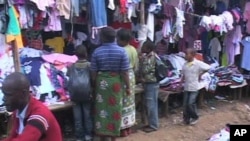The sale of second-hand clothing, called "mitumba," is widespread in Kenya. But while mitumba may benefit the pocketbooks of many people, especially the poor, critics say it harms the country's domestic textile industry.
It is a typical day at Toi Market in the Nairobi informal settlement of Kibera. Buying used clothing, or "mitumba," is very common in Kenya. Shoppers hunt for the best deals on shirts, trousers, dresses and other clothing.
"Kenyans find it a bit easier [to purchase mitumba] than going to the shop and spending much more money over there. So they find it cheaper, to come over, choose from mitumbas, and then they get it done," explained Kelynne Wambui, one of the sellers.
But while the mitumba business may be good for Wambui and her customers, others say it hurts Kenya's struggling textile industry.
Mitumba first came to Kenya in the late 1980s at a time when the textile industry was booming, employing some 30 percent of the formal labor force. But economic liberalization policies that included the mass importation of used clothing led to the textile industry's virtual collapse by the early 1990s.
In 2000, the signing in the U.S. of the African Growth and Opportunity Act (AGOA) briefly revived the textile industry, but mostly in the export sector rather than the domestic market.
Last year, the government reduced import duties on second-hand clothing, leading the Kenya Association of Manufacturers to predict further job losses. The Kenyan textile industry currently employs less than 20,000 workers from more than 200,000 at the peak of the industry.
Big impact
Jaswinder Bedi is chairman of the Kenya Association of Manufacturers. He says the introduction of mitumba in Kenya had a huge impact on the textile industry.
"And why did it? Purely because you cannot compete with free things," said Bedi. "I mean, if you are trying to compete with something which is really free of cost, you cannot. You have a cost of manufacturing, you have a cost of raw material, you have a processing cost. And, all those costs put together, you cannot compete with that."
Bedi calls mitumba "free" because most of the garments sold are actually donations made by people in North America and Europe, who think they are sending their used clothing to the poor for free distribution.
He says he has no problem with clothing being distributed to the poorest of the poor for free, but that donations should not be made into a business.
For Bedi, a bigger problem is that a high percentage of imported clothing escapes the tariff by being smuggled into Kenya through what he calls "porous borders."
Unfair competition
Moses Ikiara is the executive director of the Kenya Institute for Public Policy Research and Analysis. He says it is not just mitumba that evades the taxman.
"New imported clothing comes in disguised as mitumba and it gets into the market, and of course without paying taxes, which makes it a big challenge for domestic textile producers to be able to find a market. Problems like those have to be sorted out," said Ikiara.
But there are some who believe that the domestic textile industry can compete effectively with mitumba. Richard Ndubai is CEO of Ricardo International, which manufactures and exports garments for Walmart and other American outlets. He plans to start producing for the Kenyan market.
"A lot of the mitumba that is coming into the country now is basically goods that are manufactured in Africa, in Kenya, which end up in countries like the U.K., America, Italy. They are then used by people for one or two months. They bale the same product up and bring it back to sell to us," said Ndubai.
Game plan
Ndubai says that if the textile industry focuses on mass production, and if manufacturers in the Export Processing Zone are allowed to produce for the local market, companies in Kenya can sell clothing to Kenyans at the same price as mitumba or even cheaper.
Industry leaders are urging the Kenyan government to support the domestic textile industry. They seek a ban on the sale of mitumba, a crackdown on mitumba smuggling and broad changes in the cotton industry.
